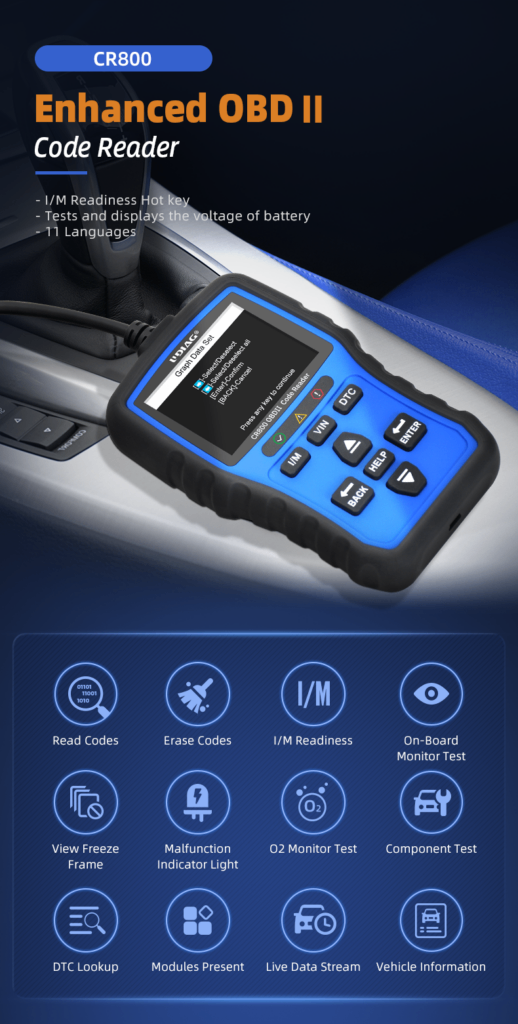Demystifying Diagnostic Trouble Codes for Everyday Drivers
2023-11-07 by UDIAG
As you zip down the road, your car might suddenly illuminate a colorful array of warning lights on the dashboard, leaving you baffled and anxious. These enigmatic signs aren’t just random blinks; they’re Diagnostic Trouble Codes (DTCs) – cryptic messages from your car’s engine control unit (ECU) trying to convey what’s amiss under the hood.
For many drivers, these codes seem like an unsolvable riddle or a secret language only understood by seasoned mechanics. However, fear not! This article is here to unravel the mystique of Diagnostic Trouble Codes for everyday drivers, breaking down the complexities into easily digestible insights. Let’s embark on this journey to empower ourselves with the knowledge to interpret and address these codes confidently.

I. Understanding Diagnostic Trouble Codes: The Basics
What Are Diagnostic Trouble Codes (DTCs)?
- DTCs are numerical codes produced by your vehicle’s onboard computer systems to indicate issues in various components.
- They serve as a diagnostic tool, signaling problems within the engine, transmission, or other systems.
- Each code corresponds to a specific issue or fault, providing a starting point for troubleshooting.
Types of Diagnostic Trouble Codes
There are different categories of DTCs:
- Generic Codes: These are standardized across all vehicle manufacturers and provide general information about the issue.
- Manufacturer-Specific Codes: Uniquely designed for particular vehicle makes, they offer more detailed insights into specific problems.
- Pending Codes: These are potential issues detected but not yet confirmed as faults. They often need further observation or repeated occurrence to trigger a confirmed DTC.
II. Decoding Diagnostic Trouble Codes: How to Interpret Them
Retrieving DTCs
Before you can decode the DTCs, you need an OBD-II scanner. Here’s how:
- Get an OBD-II Scanner: Purchase or borrow a scanner compatible with your vehicle’s make and model.
- Locate the Diagnostic Port: Typically found under the dashboard near the steering column.
- Connect the Scanner: Plug it into the port and turn on your car’s ignition without starting the engine.
- Read the Codes: Follow the scanner’s instructions to retrieve the codes.
Understanding DTCs
Each DTC consists of a five-character code: a letter followed by four numbers (e.g., P0420). Here’s a breakdown:
- The letter indicates the system where the issue arises: “P” for powertrain, “C” for chassis, “B” for body, and “U” for network communication.
- The first digit indicates whether it’s a generic (0, 2, or 3) or manufacturer-specific (1) code.
- The next two digits specify the exact fault or problem.
- The final digit signifies the type of issue.
III. Making Sense of Diagnostic Trouble Codes: What Do They Mean?
Interpreting DTCs
Once you’ve retrieved the codes, the challenge is deciphering their meaning. While it’s tempting to jump to conclusions, it’s crucial to consult a reliable database or manual to translate the codes accurately. Here are a few common DTCs and their implications:
- P0300 – Random/Multiple Cylinder Misfire: Indicates issues like a faulty spark plug, fuel injector, or low compression.
- P0420 – Catalyst System Efficiency Below Threshold: This might signal problems with the catalytic converter or oxygen sensors.
- C0561 – ABS System Disabled Information Stored: Typically, this suggests issues within the anti-lock braking system.
Taking Action on DTCs
So, you’ve decoded the code – what’s next?
- Research and Consultation: Look up the code or seek guidance from experienced sources to understand the issue’s severity.
- Assess the Vehicle: Check for visible signs, strange noises, or changes in performance that might align with the reported problem.
- Professional Assistance: For complex issues or if you’re uncertain, consulting a qualified mechanic is advisable.
Conclusion
Demystifying Diagnostic Trouble Codes for Everyday Drivers isn’t an insurmountable challenge. Armed with a basic understanding of these codes, you can approach car troubles with confidence, making informed decisions and seeking timely solutions. Remember, while DTCs provide a helpful insight into your car’s health, professional guidance can be invaluable in complex situations. Embrace this knowledge to navigate the road ahead, ensuring a smoother and safer journey for you and your vehicle!
So, the next time your dashboard lights up like a Christmas tree, don’t panic! It’s just your car trying to communicate, and now, you’re fluent in its language of Diagnostic Trouble Codes. Time to decode and drive on!
As we demystify Diagnostic Trouble Codes for everyday drivers, remember that knowledge is your vehicle’s best passenger – helping you navigate the roads with confidence!
FAQs
1. Can I ignore a DTC if my car seems to be running fine?
A: While your car might seem okay initially, ignoring a DTC can lead to more significant problems in the future. It’s advisable to address the issue promptly to prevent further damage.
2. Are DTCs always accurate?
A: DTCs provide a starting point for diagnostics, but they might not always pinpoint the exact problem. They serve as a guide, and further investigation is often necessary.
3. Can I clear DTCs myself?
A: Yes, many scanners allow you to clear codes, but it’s essential to identify and rectify the underlying issue before doing so. Clearing codes without solving the problem may cause it to recur.
4. Are there codes that I can ignore?
A: It’s prudent to investigate all DTCs. Even if a code seems minor, it might indicate an underlying issue that could worsen over time.


